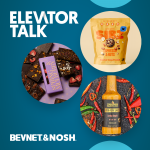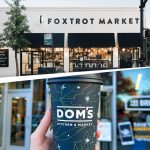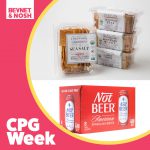Capitalizing on Craft: CPG Cashes In on Beer’s Success

You don’t have to be in craft beer to know that it’s a business that is doing something right. Craft beer was a $26 billion industry in 2017 alone, seeing 8 percent dollar sales growth from the year prior. While industry sales are starting to reflect that of a more mature market, the Brewers Association said craft beer accounts for more than 23 percent of the $111.4 billion U.S. beer market.
And the popularity of craft is changing the game for more than just brewers. It has given rise to a craft culture that is reflective of consumers’ high expectations for food and non-alcoholic beverage products, as well. Inspired by the local, bespoke nature of the craft beer movement, consumers are seeking out regional, high-quality, hand-made or small batch items more than ever before.
That has given rise to a movement in craft foods, but also to partnerships: some food and beverage brands are trying to create excitement by partnering with and taking notes from beer leaders on everything from innovations and packaging to distribution and marketing strategies. The result: booming business brewed for all industries involved.
A Shared Consumer
The businesses of beer and food may have numerous logistical and operational differences, but fundamentally they have a lot in common. A main similarity is that the natural food and beverage industry and the craft beer industry share a core consumer.
Melissa Abbott, VP of retainer services at consulting firm the Hartman Group, told NOSH that she thinks the “super nerds” of the beer world are a subset of a larger group of consumers who openly explore other craft categories, in particular food.
“This consumer is seeking a premium product created with care and integrity by nice people who are passionate about food,” Abbott said. “Beyond beer in the craft category, the food-forward consumer seeks novelty and culinary inspiration with wellness cues — think Smoked Cola Gumdrops from Quinn Candy and small-batch handmade old-world yogurt from White Moustache.”
Matt Tolnick, founder of Lawless Jerky, said that craft beer consumers are looking for something that is more independent and a little bit unconventional, with flavors that might not be available in most mainstream channels.
Brett Joyce, President of Rogue Ales and Spirits, said he thinks craft beer’s small batch process has allowed them to capture that movement faster than the manufacturing processes of most other industries would allow.

Emerging food and beverage brands, however, are able to more quickly adapt to changing consumer desires than the large food conglomerates, which is helping them gain a larger share of the market. Even brands like Prop & Peller, a German-style pretzel maker that has built its entire business around the concept of Germany’s purity law, is launching its first seasonal and flavored pretzel lines in 2018 to better match the bold and interesting flavors coming from beer.
“German purity law says nothing goes into beer except its main four ingredients — and that has been our philosophy with our pretzels up until this point,” Prop & Peller president and founder Claudia Maria Hillmeir said. “But now even Germany is questioning this law because it may be limiting variety. It’s time to open that up a little. I think we can still be pure with our ingredients but add a little variety as long as it’s in a natural way [that stays] true to what makes our pretzels our pretzels.”
It’s all in the name of differentiation and appealing to consumers’ love for “experiences,” Dogfish Head president Sam Calagione told NOSH. Still, there is a balance that both brewers and CPG brands need to find in order to see success.
“It’s a double-edged sword because it rewards innovators, but it also creates an expectation of super quick innovation that makes headwinds for establishing a brand because they don’t want the same thing they had last time,” Calagione said. “So how do you establish a brand in a world that is promiscuous in terms of what they are going to by next?”
A Taste For Craft
Craft brands are seeing success, but with the addition of more emerging players, brands and brewers jostle for market share with fellow startups and shelf-hogging mega brands. In an effort to expand their appeal to more consumers without losing their acclaimed authenticity, craft food, beverage and beer brands are joining forces to make the most of their innovation efforts.
Some food brands are searching for ways to appeal to beer drinks by actually putting brews in their products. Last year, Allagash Brewing began selling truffles made with its beer in their taproom, produced by Portland chocolatier Laura Rudy, of La Crème Chocolat. The brewery also produces its own vinegar and is working with Winter Hill Farm in Freeport, Maine, on a soft cheese washed in the brewery’s triple. Rogue has previously collaborated with food makers and continues to align itself with Rogue Creamery, a Oregon-based artisan cheese company, that makes a chocolate stout cheddar using Rogue’s ales. The company is also known for its nod to Sriracha with its hot stout beer.
Specialty brands are not the only ones partnering with beer. White Moustache, a NYC-based, small-batch yogurt company, is working with Brooklyn Brewing to make a beer that uses some of the whey from their yogurt making process. Similarly, Mrs. Renfro’s salsa is incorporating Texas-based Rahr and Sons Brewing’s red ale for a recently launched craft beer salsa.
Then there are collaborations rooted in brand recognition rather than in the product itself. Guinness is using licensing deals to leverage its consumer recognition in the food space. This fall Brand Castle, a manufacturer of interactive baking kits, announced its collaboration with Guinness in order to launch stout flavored bakery products for the holiday season. Guinness also licences its name to Burt’s Chips, which tosses its thick-cut potato chips with a blend of roasted barley and hops to be reminiscent of the Irish stout.

The innovation inspiration flows the other way as well. Jennifer Glanville, brewer and director of experiences at the Samuel Adams Boston Brewery, told NOSH she thinks of the brewery as a “test kitchen.”
“We brew with the highest quality ingredients from malt and hops to Japanese yuzu wood, Balaton cherries, TCHO chocolate and even beef hearts,” Glanville said. “Our brewer’s inspiration comes from everywhere – we’re constantly asking ourselves ‘what if?’ While our passion lies with brewing and drinking craft beer, we’re always discovering new flavors and ingredients, especially through [food].”
Calagione told NOSH that since the brewery’s inception he’s looked to the culinary world for inspiration rather than toward European beer styles. While he’s had a Delaware-based restaurant since the brewery opening in 1995, in 2012, he made the plunge into packaged food when he joined forces with Brooklyn Brine’s Shamus Jones to make a hop-forward pickle. The resulting product, The Hop-Pickle, used the DNA of Dogfish’s 60-minute IPA and was sold in Whole Foods and various wine stores.
But scaling a product with beer as an ingredient can be difficult, as both Calagione and Jones learned. Jones told NOSH that while the collaboration was a top-selling product, it never surpassed that of the brand’s signature SKUs due to what he thinks was consumer confusion. Dogfish Head decided to pull away from the product, which was discontinued in 2016, to focus its resources back to beer and building a new canning line. Both, however, said the partnership was a positive learning experience.
“Our resources and capabilities didn’t let us thrive in the food aisles in the same way it has allowed us to thrive in the beer aisles,” Calagione said. “We were like, ‘Dogfish Head has been from day one all about food-infused beers, why can’t we be successful in beer infused food?’ We learned pretty quickly from the moment when we tried to distribute beer-infused foods through the outlets where there is volume — chains and retail stores … that there are really specific nuances to the different categories that create real challenges when intertwined.”
Regrained, a snack maker that collaborates with breweries to make granola bars and flours from spent grains, also struggled to find a balance in how they communicate their beer-in-food product. Regrained operations manager Harrison Laine, who directly creates all the brand’s partnerships with breweries, said that though beer drinkers and brewers understand what spent grains are and appreciate the direct connection to beer, others are confused.

Because of this, the company has redesigned its packaging to remove the beer call-out, instead referring to the spent grains as a “supergrain.” Its first product in the new look, a Blueberry Saison bar, launched last month.
All brewers and brands interviewed for this article — both those who have centered their collaborations around beer’s taste and those who have not — said they think the success and sales of these collaborative products are more deeply rooted in consumers’ appreciation for both players’ shared values and their desire to make premium products.
“I think the real parallel is the paradigm shift in the market about what’s authentic, what’s differentiated, what’s high quality, [and] what has clean ingredients,” Jones said. “That was one of the first things we said to Sam. We are on a parallel journey and we can already see it; we’re just 20 years behind [them].”
Tapping Into Beer’s Retail Success
A recent Nielsen survey found that 71 percent of craft-beer drinkers say they buy beer to complement their food. To fulfill this unsurprising need, some craft food brands are positioning their packaged products as pairings with consumers’ favorite brews.
That’s a notion Prop & Peller has built its entire business model on.
Aside from looking to Germany’s beer purity law, the pretzel maker also looked to beer when shaping a distribution strategy around restaurants, taprooms and events where beer is served. Currently, about 80 percent of the company’s sales are beer related, with 20 to 30 percent of those sales coming from breweries, taprooms and craft beer-related events, according to Hillmeir. The pretzels are sold in breweries like Troegs Brewing, Von Trapp Brewery, Lost Rhino Brewing Company and Fat Head’s Brewery, as well as in select Disney parks and in all 100-plus World of Beer restaurants.
“[Craft beer has] created an awareness around quality and the making of a product, and we’re starting to see that interception with consumers now applying that to other categories, like food and pretzels,” Hillmeir said.
Prop & Peller is not the only brand playing with the idea of breweries as retail locations. Lawless Jerky, Chef’s Cut, Chico de Gallo, Mi Nina and Spindrift are among many brands working with brewers to give consumers something to snack on or drink when their breweries don’t have the space or funds to transform their tasting rooms into brewpubs.

CPG entrepreneurs interviewed for this article all noted that they don’t see taprooms as a viable distribution channel, but rather an experiential marketing expense to connect with new consumers they don’t reach in their typical retail locations. Chefs Cut CEO Bart Silvestro said that he thinks the brand’s presence in breweries in particular has helped the company stand out on shelves in grocery and convenience.
“I find today’s younger generation is more about the experience than it is about the product that they are buying. They want memories… We want to align with breweries because we feel that our jerky is an experience, a chef’s experience,” Silvestro said. “When you had that good experience at the brewery, the conversion to sale at shelf is a lot easier… You need something to resonate when that customer is standing in front of that rack so when they see those two pegs, they think ‘let me grab that.’”
Will the Keg Ever Kick?
CPG companies have worked with and been inspired by the craft beer industry over the last decade, and it’s translated into more sales and stronger communities for many brands. Still, craft beer growth has begun to flatten a bit. That trend doesn’t scare Hillmeir.
“Even if there is a slowdown or flattening in the industry, consumers will never go back,” she said. “They don’t want industrial beer, and it’s to the point that even the big companies have raised their bars. Consumers want the overall quality and standards of craft.”
Abbott agreed, advising entrepreneurs looking to be inspired by, or innovate with or alongside beer to consider that the products with the most potential for long term growth often include categories reflecting care in production, less commoditized ingredient sourcing and chef-driven values. Craft beer is known to exemplify many of these values along with a sense of whimsical humor, all positive attributes for consideration in categories beyond craft beer.
Calagione added that the best learning lesson that brands can take from the wins and struggles in craft beer is the importance of winning across what he calls the three “barrels of success.”
“The consumer has voted and they are making choices — whether it is food and beer — on quality, consistency and being well differentiated,” he said. “Any brand that does those three things well, will succeed and grow. But the grassroots community and conversation around these products is so immediate and profound in terms of reach that you can’t front and just do one or two of those. You have to do all of those three. It’s the consumers deciding what brands, regardless of scale, deserve to thrive and which ones deserve to go away.”













